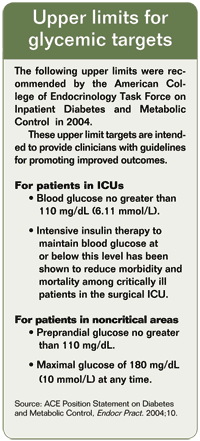IV insulin control adapted to intermediate-care units
Method of maintaining blood glucose control was implemented with a nurse-patient ratio of 1-to-5.
Hospitalized patients who require strict glycemic control may now be able to receive IV insulin while in an intermediate care unit instead of having to be transferred to intensive care. Researchers from Duke University Medical Center have succeeded at implementing a new IV insulin administration method that allows for a lower nurse-patient ratio.
“There is a widely accepted understanding that tight control of blood glucose in acute-care facilities saves lives, cuts infection rates, shortens time in intensive care and thus may reduce hospital length of stay and save money,” said Ellen D. Davis, MS, RN, CDE, a diabetes clinical nurse specialist in the department of advanced practice nursing. Managing IV insulin treatment has required a nurse-to-patient ratio of 1-to-1 or 1-to-2.
“It was our intent to demonstrate that this more sophisticated method of [administering] IV insulin could be done outside of intensive care units,” Davis told Endocrine Today. “Patients could be spared the inconvenience and cost of acute care nursing areas.”
New methods
Davis and colleagues were among a group of nurses who implemented the new nomogram IV insulin method. This three-month trial evaluated the safety and efficacy of applying the new method to nonintensive-care unit settings.
The trial required health care professionals to use a new method of calculating hourly dose titration in two intermediate care units. The results were published in the Diabetes Educator.
 “The nurses in the study were from general medicine units and were accustomed to doing the hourly blood glucose testing required of any kind of IV insulin regimen,” Davis said. “The ‘old’ or previous IV insulin protocol produced cruder, less exact titration results with subsequently more hyperglycemia and hypoglycemia and a longer time spent on IV insulin.”
“The nurses in the study were from general medicine units and were accustomed to doing the hourly blood glucose testing required of any kind of IV insulin regimen,” Davis said. “The ‘old’ or previous IV insulin protocol produced cruder, less exact titration results with subsequently more hyperglycemia and hypoglycemia and a longer time spent on IV insulin.”
In addition to hourly blood glucose readings, the new nomogram results required careful matching and reading of multiple columns and the use of a calculator, Davis said.
Hourly rates
Under the new method, a nurse would record the hour and new insulin rate on an audit tool in addition to a patient’s chart. A second nurse was used to independently check the accuracy of the new rate, and the rates were compared.
The trial ended with 22 patients having received IV insulin. Of those, 275 correct hourly-rate calculations were done out of a possible 276. Audit and staff feedback tools indicated that the new system could be used effectively in units with nurse-patient ratios of 1-to-5 or 1-to-6.
Applying this new method of IV insulin could provide benefits for many patients, Davis said. “Extreme hyperglycemia could be brought quickly under control without the need for a transfer to an intensive-care unit,” she said. “Additionally, patients in intensive-care settings on IV insulin can be transferred out to intermediate-care units appropriately sooner and have their IV insulin continued as needed.”
As a result of this trial, the Duke center expanded the use of this method to other adult units, and nurses who were not accustomed to performing hourly blood glucose tests or using the new nomogram were given in-service education classes. – by Leah Smith
For more information:
- Davis ED, Harwood K, Midgett L, et al. Implementation of a new method intravenous insulin method on intermediate-care units in hospitalized patients. Diabetes Educ. 2005;31:818-823.
- Lien L, Spratt S, Woods Z, Osborne K, Feinglos M. Optimizing hospital use of intravenous insulin: Improved hyperglycemic management and error reduction with a new nomogram” Endocrine Pract. 2005;11,240-253.
